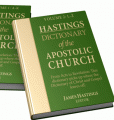Hastings, James – Dictionary of the Apostolic Church
Edited by Biblical scholar James Hastings, Dictionary of the Apostolic Church contains all definitions of people, places, and theological terms from the book of Acts to the book of Revelation. With over 1,500 pages of summaries, maps, and abbreviations, there are over 100 Biblical scholars and pastors supplying the essays. More of an encyclopedia, this collection is the perfect resource for teachers, pastors, and anyone wanting a thorough yet concise summary of New Testament themes. The entries are easy to read yet theologically sound.
Like the other works of Hastings, this compilation seeks to aid pastors and general Bible readers in understanding Scripture. Hastings, James – Dictionary of the Apostolic Church
Courtesy of Biblesupport.com
Edmondson Scripture Views of the Heavenly World is an excellent work on heaven. What is in heaven, what is not in heaven, so as to prepare the believer for when they get there.
Sample Entry
Abyss
Hastings – Dictionary of the Apostolic Church DAC (hosted on theword-dictionary-modules.com )
This is the Revised Version rendering of the word ἄβυσσος which occurs in Luk. 8:31; Rom. 10:7; Rev. 9:1-2; 9:11; 11:7; 17:8; 20:1, 3. In Lk. and Roman Authorized Version translates ‘deep’; in Rev., ‘bottomless pit’-no distinction, however, being made between τὸ φρέαρ τῆς ἀβύσσου in Rev. 9:1-2 (Revised Version ‘the pit of the abyss’) and ἡ ἄβυσσος simply in the remaining passages (Revised Version ‘the abyss’). ἄβυσσος (from α intens. and βυσσός, Ion. βυθός, ‘the depth’) occurs in classical Greek as an adj. moaning ‘bottomless,’ but in biblical and ecclesiastical Greek almost invariably as a substantive denoting ‘the bottomless place,’ ‘the abyss.’ The word is found frequently in the Septuagint , usually as a rendering of the Heb. tehôm, and primarily denotes the water-deeps which at first covered the earth (Gen. 1:2; Psa. 103:6) and were conceived of as shut up afterwards in subterranean storehouses (Psa. 32:7). In Job 38:16 f. the abyss in the sense of the depths of the sea is used as a parallel to Hades; and in Job 41:23 (Septuagint ) the sea-monster regards the Tartarus of the abyss as his captive. In Psa. 71:20 ‘the abyss’ is applied to the depths of the earth, and is here evidently a figurative equivalent for Sheol, though it is nowhere used in the Septuagint to render the Heb, word. In the later Jewish eschatology, where Sheol has passed from its OT meaning of a shadowy under world in which there are no recognized distinctions between the good and the bad, the wicked and the weary (cf. Job 3:17; Ecc. 9:5), and has become a sphere of definite moral retribution, the conception of the abyss has also undergone a moral transformation. The Ethiopian Book of Enoch is especially suggestive for the development of the eschatological conceptions that appear in pre-Christian Judaism; und in the earliest part of that book the fallen angels and demons are represented as cast after the final judgment into a gulf (χάος) of fire (10:13, 14), while in 21:7 the chasm (διακοπή) filled with fire (cf. τὸ φρέαρ in Rev. 9:1-2) is described as bordered by the abyss. Apparently the abyss was conceived of as the proper home of the devil and his angels, in the centre of which was a lake of fire reserved as the place of their final punishment.
The previous history of the word explains its use in the NT. In Rom. 10:7; where he is referring to Deu. 30:13; St. Paul uses it simply as the abode of the dead, Sheol or Hades-a sense equivalent to that of Psa. 71:20. In Luk. 8:31 the penal aspect of the abyss comes clearly into view: it is a place of confinement for demons. In Revelation we are in the midst of the visions and images of apocalyptic eschatology. In Rev. 9:1-2 ‘the pit of the abyss’ sends forth a smoke like the smoke of a great furnace. The abyss has an angel of its own whose name is Abaddon (q. v. [Note: quod vide, which see.] ) or Apollyon (Rev. 9:11). From it ‘the beast’ issues (Rev. 11:7; 17:8), and into it ‘the old serpent which is the Devil and Satan’ is cast for a thousand years (Rev. 20:1-3).
Literature.-The Commentaries and Bible Dictionaries; article ‘Abyss’ in Encyclopaedia of Religion and Ethics .
J. C. Lambert.
More Modules from this Category
- Moulton and Milligan – Vocabulary of the Greek NT
- Thayer’s Greek Lexicon
- Jewish Reference Dictionary of People, Places, Plants & Animals
- Morrish Bible Dictionary
- King James Version Dictionary
- Orr ISBE International Standard Bible Encyclopedia
- Brown-Driver-Briggs plus Thayers
- Strong Diccionario Griego y Hebreo al Español
- Wilson’s Dictionary of Bible Types
- Wace, Henry – Dictionary of Christian Biography and Literature
hastings-james-apostolic-church-dictionarybibdctwm.dct_.twm
Advertisement
Trying to figure out how to use theWord Bible program in your Bible study? Click here to find out how. This is an overview of what to expect from theWord, what it can and cannot do.

No Comments
Comments are closed.